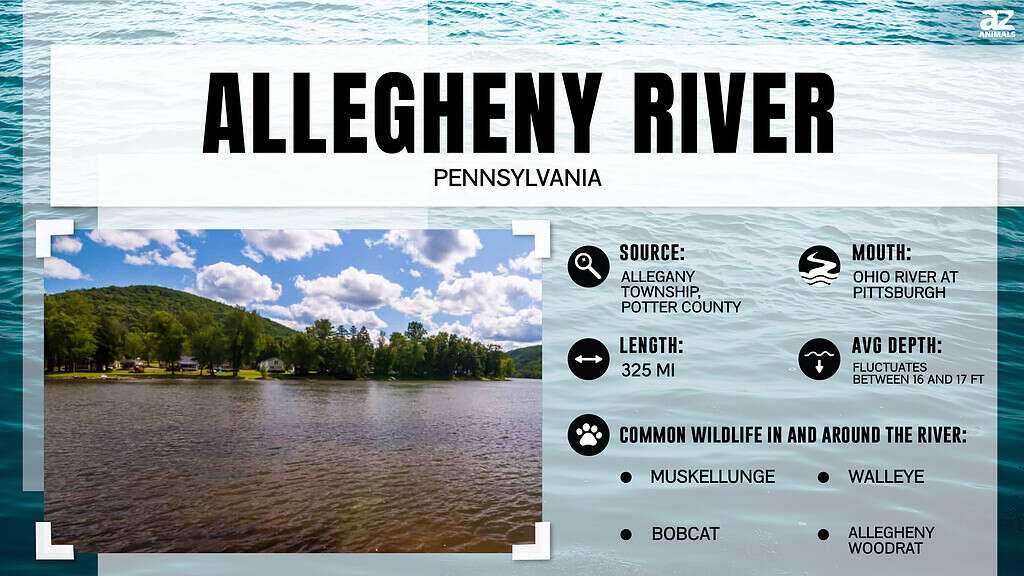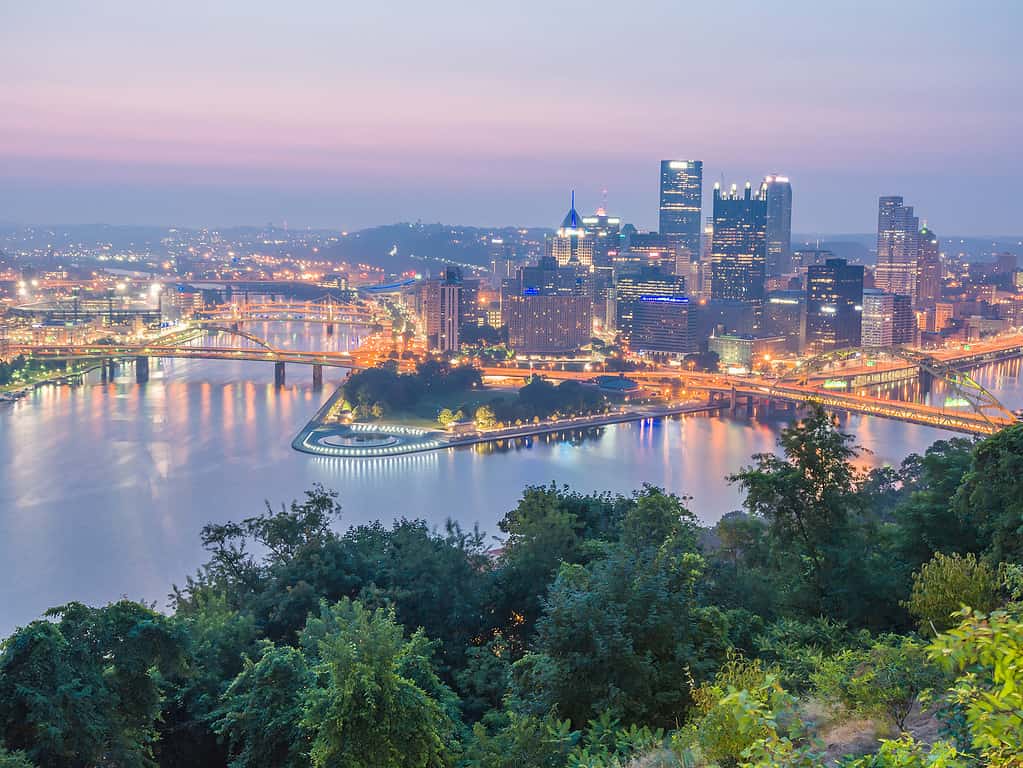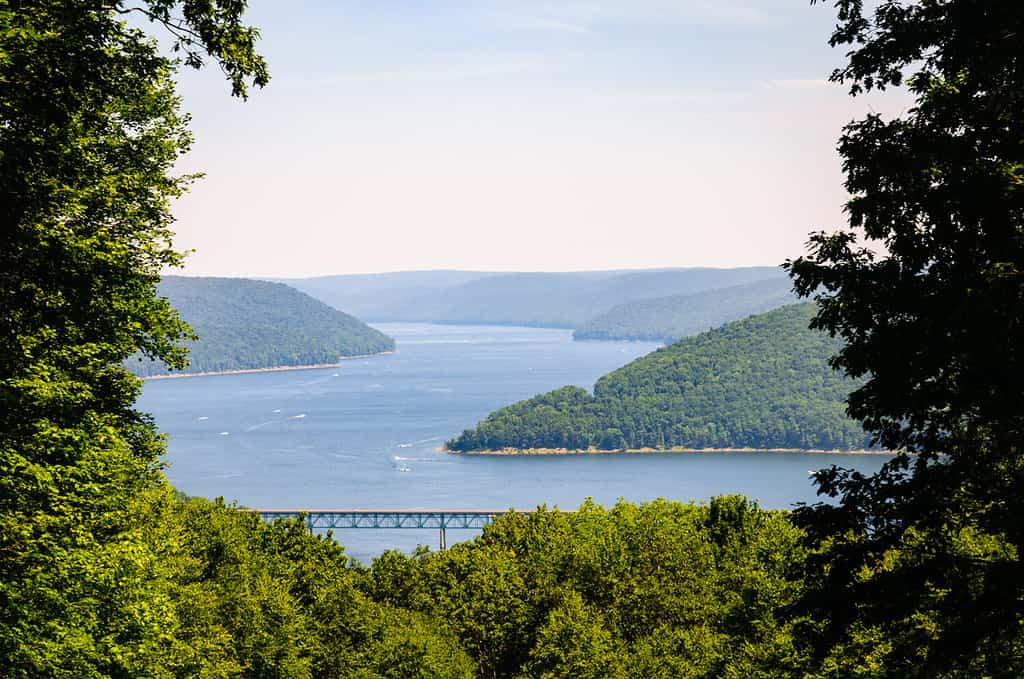The Allegheny River is a body of water located in Pennsylvania. The river flows for a total of 325 miles through the state before reaching its mouth at the Ohio River, having a total basin size of 11,580 square miles. Along its path, the river flows through some fairly large towns and cities. So, what’s in the Allegheny River, and is it safe to swim in? Learn about the wildlife in and around the river, whether or not it’s polluted, and find out if you should take a dip in its waters.

Where Is the Allegheny River?
Before considering what is in the water, it is necessary to know where the river is located. The headwaters of the Allegheny River are located in Allegany Township in Potter County. Specifically, the headwaters start near Ben Green and Cobb Hill Roads.
These headwaters are in the northern central part of the state. From there, the river takes a long, generally southwest course through the state. Eventually, the river reaches Pittsburgh, ending at the confluence with the Monongahela River at Point State Park.
Finding this river on a map is simplest by starting at Pittsburgh and tracing the Allegheny River back to its source. Interestingly, the source of the Allegheny River is also the main headwater of the Mississippi River by water volume.
After all, the Allegheny River contributes about 60 percent of the water flow at the Ohio River, a river formed by the confluence of the Allegheny and Monongahela Rivers. The Ohio River contributes most of the Mississippi River’s water flow. So, the Allegheny River is very significant from a hydrological standpoint.
What Is in the Allegheny River?

Smallmouth bass are a popular target for anglers that fish the Allegheny River.
©CLP Media/Shutterstock.com
A variety of pollutants, fish, amphibians, and reptiles are in the Allegheny River. However, not all sections of the river are polluted, so it is better to focus on the wildlife that lives and thrives in the river. Some of the fish that live in the water of the Allegheny River include:
- Smallmouth bass
- White bass
- Crappie
- Muskies
- Walleye
- Northern pike
- Brown trout
- Common carp
The river is especially known for its bass, walleye, and carp populations, but anglers come to pursue a wide variety of different fish in the region. The river’s length ensures that people can find plenty of remote places to catch fish.
The Allegheny River has been called one of the most snake-infested rivers in Pennsylvania. Some of the snakes that live near these waters include:
- Eastern milk snake
- Eastern garter snake
- Northern water snake
- Northern rough green snake
- Queen snake
These snakes are the most common that people will find along the Allegheny River. While these snakes are not venomous, Pennsylvania does have some venomous snake species that one can encounter in the wild as well. Specifically, timber rattlesnakes, eastern massasauga rattlesnakes, and copperhead snakes live in the state.
Several species of amphibians also live along the river. Anyone that travels in the wooded or marshy areas near the river may happen upon some amphibians, including:
- Spotted salamanders
- Eastern box turtles
- Painted turtles
- Eastern hellbender
These creatures are a little more difficult to spot, but they’re out there. All in all, the Allegheny River has many different species living in its waters and along its banks.
Is the Allegheny River Polluted?

The Three Rivers of Pittsburgh, an area where the Allegheny and Monongahela Rivers join to form the Ohio River.
©Jesse Lee Tucker / CC BY-SA 4.0 – License
Yes, parts of the Allegheny River are polluted, but the river is also getting better in many respects. The towns and cities along the Allegheny River engaged in heavy industry for over a century, and some of that industrial activity continues into the present day.
Some of the pollution stuck around as a legacy of the old steel mills and factories that once dumped chemicals into the river. Generally, the closer one gets to the end of the river, the worse the water quality gets.
It is not right to put a blanket statement saying not to eat fish from the river. However, it is also not advisable to eat a large number of fish from the river, either. After all, the fish in some parts of the river still test positive for mercury and polychlorinated biphenyls, also called PCBs. As a result, some agencies have said that people should not consume fish from the river more than once a week at best. Some species are worse to eat than others.
Another major issue in the Allegheny River region stems from sewage being dumped into the river. Sewer overflows dump billions of gallons into the Three Rivers (Allegheny, Monongahela, and Ohio Rivers) in Pennsylvania. Sewage can pose a serious health threat to people that enter the waters.
Although pollution is still a problem, it is not as rampant as it was before. The river is best described as slow healing. Concerns over fracking water treatment sites on the river, sewage containment, and others continue to plague the Allegheny River.
Can You Swim in the Allegheny River?

Greater numbers of people are taking part in water recreation on the river these days.
©Zack Frank/Shutterstock.com
Yes, you can swim in the Allegheny River. However, there are some caveats to that statement. For one thing, it’s important to never swim in the river after heavy rain. All sorts of chemicals and sewage can flow into the river during a storm. Also, the water can be turbulent after a heavy storm, presenting a risk to the people in the river.
Aside from that, more and more people are taking up water recreation in the Allegheny River. They go boating, fishing, and even swimming in some parts. Of course, the cleanest portions of the river are upriver and away from major cities like Pittsburgh.
Some of the biggest risks include a lack of lifeguards at many places along the river and E-coli after a heavy rainstorm. So, before a person swims, they need to check the conditions of the river in terms of water quality and safety. The best idea is to swim in designated areas along the river and to check any water quality stations for readings on the river when possible. All in all, you’d be better off swimming in a pool if possible.
Knowing what is in the Allegheny River may put off some people from swimming and fishing in the waters. Yet, the waters are getting cleaner every year as local governments wield new regulations and infrastructure plans in an attempt to make the river safe. For now, the river is not the cleanest place to swim, but some people still do. Just be safe when you head out on the water.
The photo featured at the top of this post is © Joseph Sohm/Shutterstock.com
Thank you for reading! Have some feedback for us? Contact the AZ Animals editorial team.






